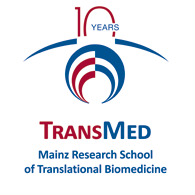Upcoming Events
Below you will find all upcoming events, such as talks, transferable skills courses, or lab courses.
All listed events carry a number of TransMed credit points corresponding to the time of attendance. 0.1 TransMed credit point is equivalent to 45 minutes of attendance.

FTN Seminar "Functional Architecture of Entorhinal Networks"
Veranstalter: FTN Focus Program Translational Neurosciences
| Datum | 13.01.2015 |
|---|---|
| Uhrzeit | 18:00-19:30 Uhr |
| Ort | UMC, Building 706, Lecture Hall, Langenbeckstr. 1 55131 Mainz
Contact: barbara.gordon-traeger@unimedizin-mainz.de |
| Zielgruppe | Scientists, Studentents and Physicians |
| Dozent | Prof. Menno Witter The Norwegian University of Science and Technology, NTNU - Trondheim- Norway. Abstract: The result of decades of multidisciplinary research identified the entorhinal cortex as a key component of the set of brain structures that are required for conscious memory. The descriptions of the perplexing variety of functional contributions of the entorhinal cortex are generally based on a deceivingly simple wiring diagram. Ever since the seminal contributions of Santiago Ramon y Cajal, superficial layers of entorhinal cortex are considered the main source of cortical input into the hippocampal formation. Added to that was the notion that the main output from the hippocampal formation back to widespread cortical domains is mediated by way of entorhinal neuronal connectivity, mainly through the deep layers. More recently, it was discovered that the entorhinal cortex contains the circuitry linking hippocampal output layers (deep) to input layers (superficial). Experimental data, largely obtained through in vitro slice physiology indicated that neurons in different layers show strikingly different basic electrophysiological properties and differences in intrinsic intralaminar and interlaminar connectivity. Variations in input connectivity between the layers have been described as well. Reports on laminar specific distribution of pathology in for example Alzheimer’s disease and medial temporal lobe epilepsy further emphasized the concept of laminar differences in the entorhinal cortex. In my talk I will summarize recent experimental data obtained with combined optogenetic, in vitro slice electrophysiological, as well as confocal and electronmicroscopical approaches. Our findings indicate that, on the one hand, anatomically different laminar input distribution may be deceiving; brain areas, such as the presubiculum and parasubiculum, that selectively distribute axons to either layer II or layer III, interact with neurons in all layers. Other inputs that selectively target one layer synapse onto neurons that strongly contribute to interlaminar connectivity. On the other hand, available data support a striking uniqueness of intralaminar connectivity, that seems even neuron-type specific. One example is the unique connectivity between stellate cells in layer II of the entorhinal cortex. Stellate cells show little to no excitatory recurrent connections. In contrast, connectivity is polysynaptic, mediated by fast-spiking interneurons. Adding to the architectural complexity is that the entorhinal cortex is essentially a ‘twin structure’ where the siblings, called lateral and medial entorhinal cortex, have comparable overall architectures but show strikingly different functions. I will present recent data indicating that a major difference between the twins may be present in principal neurons in layer II, while differences in other layers are not that evident. The siblings further differ with respect to major cortical inputs and our ongoing research addresses how different cortical inputs are wired specifically into the corresponding local circuits. Our findings indicate that the entorhinal cortex has a complex connectome that is yet only partially understood. However, even this partially known connectome allows for interferences with respect to how specific components of the entorhinal cortex may underlie different functions and show disease-related pathologies. |
| Weitere Informationen | |
| Downloads |


 International Medical Services
International Medical Services
